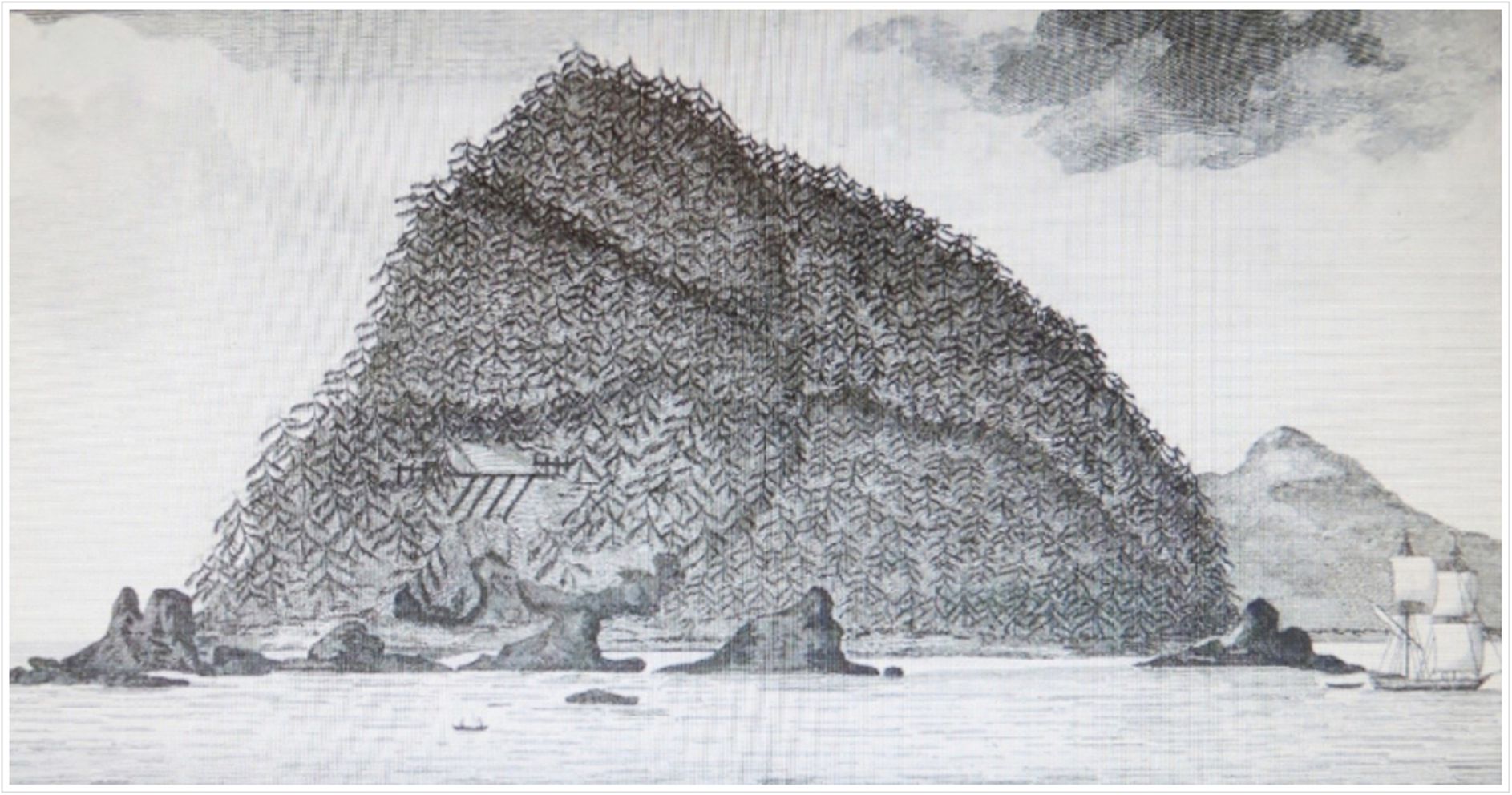October 13, 2020
By Grant Keddie
A Possible Case of a Haida Oral History that refers to an Ancient Voyage from the Northwest Coast to Hawaii.
John Swanton, as part of The Jessup North Pacific Expedition, recorded a Haida story in the period between the winter and spring of 1900-01 from an old man, known only as Walter, who belonged to the Rear-Town-People of Yan. He considered the stories of Walter to be the most trustworthy.
The narrative written in the Masset dialect of the Haida language and in English is entitled: Those Who Were Blown to Sea from Nasto. It tells the story of a man named Eagle, of the West Coast-Gi’tans – a principle Eagle family in this region and his unnamed wife, a Whale-Women belonged to the West-Coast-Rear-Town-People at the north end of Graham Island.
They were blown to sea for a month and a half until they came to a land of people who welcomed them and whom they lived with for five years. They were given instructions to return home by heading east toward the rising sun and following the birds that were then migrating to the northeast. The people the Haida couple encountered wore what could be interpreted as the red feathered capes and hats of the Hawaiian Islanders. The story tells how their hosts inquired if there was land across the ocean to the east.
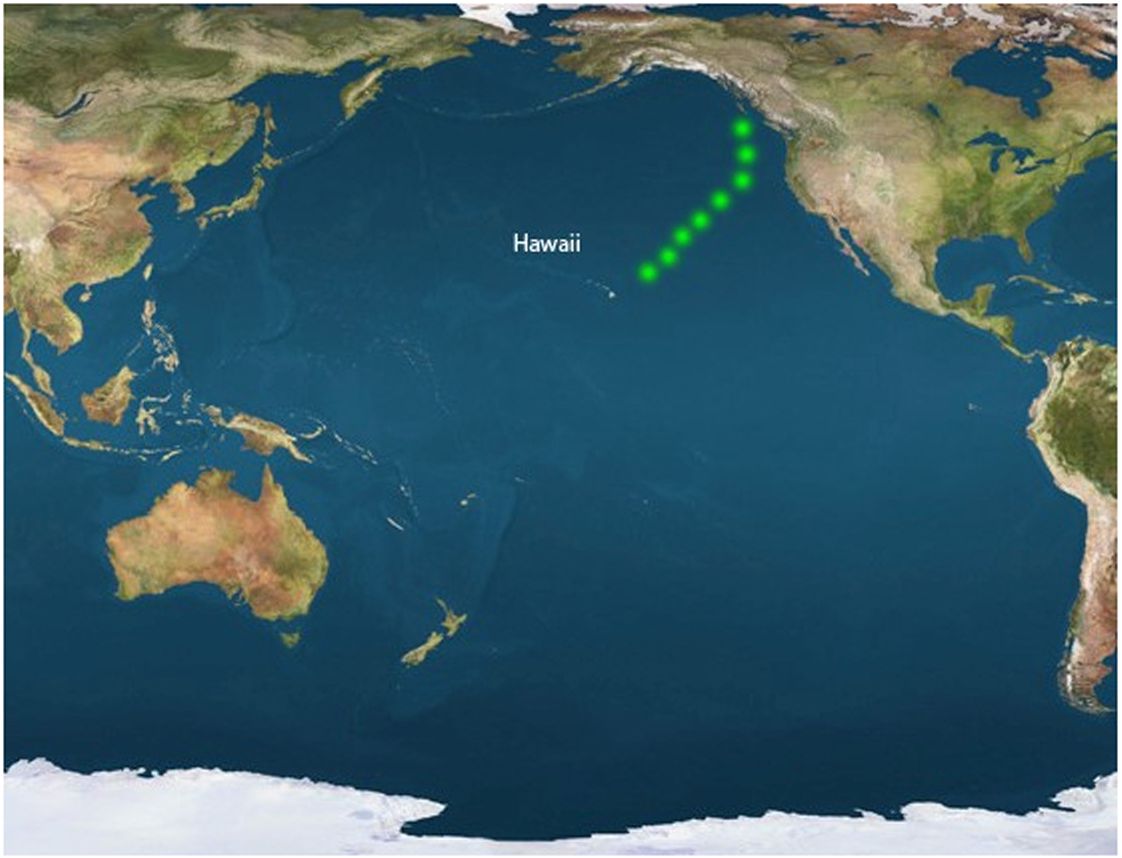
Eagle and his wife lived on Hippa Island on the west coast of Graham Island. The island was named Hippa because of its resemblance to the Maori fortified villages of New Zealand – commonly referred to as Pa. Fur trader George Dixon, on encountering Haida in several canoes on July 7th, 1787, wrote : “The place these people came from had a very singular appearance, and on examining it narrowly, we plainly perceived that they lived in a very large hut, built on a small Island, and well fortified after the manner of a hippah, on which account we distinguish this place by the name Hippah Island.” (Dixon 1789).
The artist on Dixon’s ship, Inigo Barlow, did two drawings of Hippa Island showing the defensive location on the lower left (fig. 2). An undated painting by an unknown artist in the Royal B.C. Museum collection shows a different location on Hippa Island with houses on higher up defensive locations than those of the Barlow drawings (fig. 3).

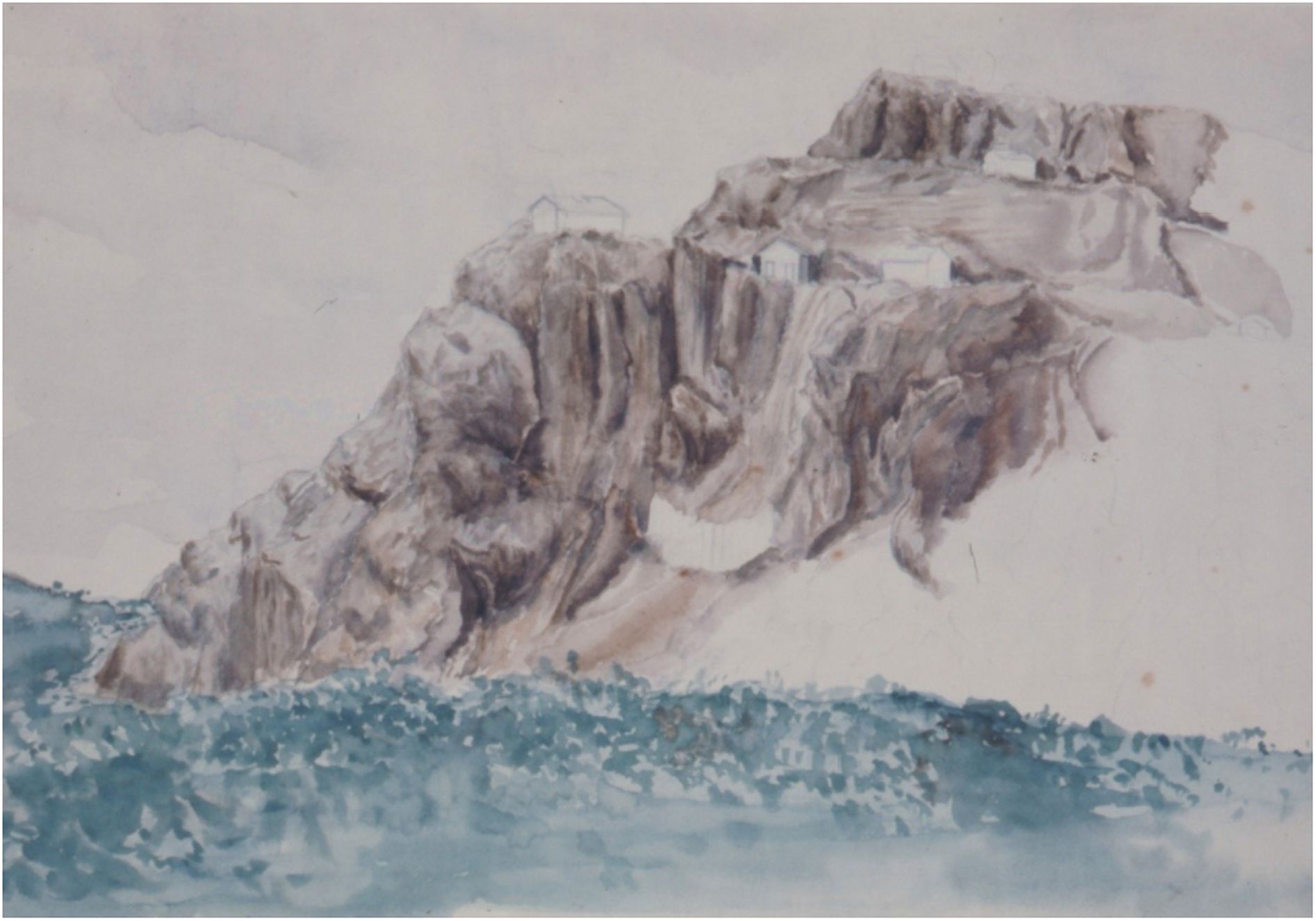
Villages in the region of the story were recorded by at the turn of the century by Dr. Charles Newcombe, whose collections became an important component of the RBCM collections. These records with other earlier sources were added to line drawings by James Swanton in his 1905 publication. Contributions to the Ethnology of the Haida. Hippa Island is referred to as Nesto in Swantons’s publication done three years later.
The sea voyage event happened, when the couple were going from Bilge-Water-Town, recorded as Cata’nas by Swanton and located on the north western coast of Hippa Island. They were headed to “QIA’ngwe” to dry salmon. This location is at the back of Seal Inlet to the south recorded by Swanton as “Ka ‘fjgwai’.’
The story tells how, when going over to “Qon-ku” (Kunakun Point south of Skelu Bay) to the south-east of Hippa Island, a north wind blew them offshore near Crab reef, but then: “They were driven seaward a whole month and a half. They had much water [drinking water] in their canoe and a square box full of food. After the month and a half was expired. They came in sight of land. And next day they were blown to the land. There was a great crowd of people there. Their upper parts (perhaps coats) were red. Then they let them (Eagle and his wife) live there with themselves.

Then they gave them a small house. They were very fond of (kind to) them. And they (the strangers) had not thought that there was any land here. They asked them, ‘Is there land there (beyond the ocean)?’ They continually gave food to them. ‘There is land there’, said (Eagle).
And there was a cave there. This was full of birds. They told them to watch these. The lowest row around the inside was composed of wrens. Above them sat humming birds. Above these sat Wa’nuga. In this (cave) it was always warm. So the summer birds lived there.
While they were there, five years passed. Meanwhile their friends hunted for them. They did not know where (Eagle) was. They hunted in vain where he used to go to dry salmon. His friends wept continually for him.
At the end of four years, the Wanuga disappeared. They came across hither. Ten days afterward, the humming birds also disappeared. Ten days after that, the bees were also gone. Many days after that the wrens also disappeared. It was summer here, so they came over.
They said to him, ‘Go back. Is your land where the sun comes up?’ And he answered, ‘Yes.’ – ‘To-morrow go home,’ they said to him. Then they put water into it for (the travellers). They also put food into it for them. Then they (Eagle and his wife) went for five days. The land that they left disappeared. Then they did not see how they should go, because no land was in sight.
Then a small gull flew around above them. After it had flown around fora while, it sat on the bow. After (Eagle) had gone along for a while, and the bow turned aside from the land, (the gull) flew away from them. Then they looked at it as it flew away. And it floated far off. Then they went straight towards it. And it got into their canoe again. And they went straight towards it. And it got into their canoe again. And when they again went aside from the straight towards the land. And it floated far off. And they went to it. And it again got into the canoe. And it again sat in their canoe for a long time. Then it sat for a long time there. And when the canoe again pointed aside from their country, it again flew from them. It sat there a whole month. When this month was exhausted, another (month) opened its eyes. All that time, the gull sat in their canoe, flying away at times.
When the last (month) came, it was a little foggy. But then it sat close by them upon the water. All of the ten days while it was foggy, it swam close by them. They were afraid they would lose it. After ten days were passed, the surface of the sea was clear. Then evening came upon them. At that time it sat about in their canoe during the night. When ten days were passed, the top of a mountain appeared a little. But then this sea-gull flew away from them.
Then (Eagle) called to the killer whales. He called because he saw land. Then they saw the top of Hippa Island. At that time they poured their fresh water into the sea. He (the man) poured this water in for Raven-Fin. Afterwards he also called for Noisy-Fin. After he had spoken, something beneath him made a noise. Then they saw two killer-whales swimming in the sea. He said to them, ‘Save me!’ They did not paddle.
Then their dorsal fins came up on both sides of him. Then he said to his wife, ‘Go to the stern.’ So his wife did go to the stern. And he put his arm around the dorsal fin or one of them. He also seized the other. ‘Save me,’ he said. Then those killer-whales started off. Raven-Fin and Noisy-Fin went. The Ta’An-People (the killer-whales) sank away from them.
And evening came upon them there. And they were blown to the west of Swamp-Town during the night. And they lighted a fire there. They had given them food in a copper box?
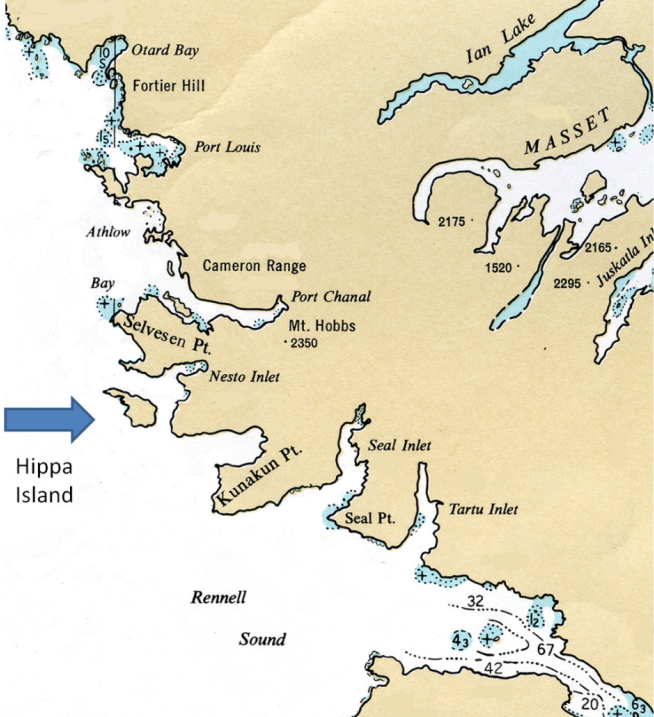
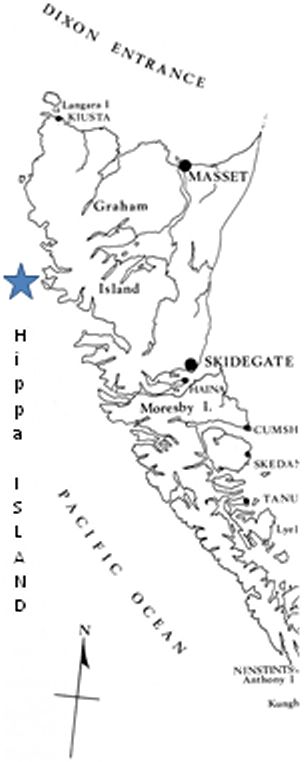

The story goes on to say that a group of people from Ninstints saw them and mistaking them as Rear-Town-People they had come to fight with, killed the man. The woman made it back to Swamp-Town and told the story to the chief of the Cod-People who was also a shaman. He asked her if she understood their language and what they gave her to eat. She said they were very kind to them and helped them to get back home. She noted they did not eat dried fish and ate “all sorts of sweet things.” Then she told them about the migrating birds and how they were saved because a bird got into the canoe. She told them about the killer-whales saving them and how her husband had been killed.
What was the migratory bird?
There are several migratory bird species that might be referred to in the Haida story. These could include, for example, the Laysan albatross (Phoebastria immutabilis), a gull-like albatross that ranges across the North Pacific. They breed in the Hawaiian Islands which are the home to over 99% of its population. The Hawaiians call it Mōlī. The Albatross has a wide range but during non-breeding seasons they show the closest movements to the coast of British Columbia (see Whittow 1993; Fernandez et.al. 2001; Young et.al. 2009; Kappes et.al. 2009).
Another migrating bird that should be considered as the bird in the story is one of the migrating species of shearwaters, especially the Sooty shearwater (Puffinus griseus) that is abundant off the coast of British Columbia. Flocks containing as many as 90,000 birds have been observed along the west coast of British Columbia in early May (Vermeer and Rankin 1984)
They are small seabirds that are one of the most abundant species in the world. They come in May to feed in the rich waters of the North Pacific and start their return journey to their breeding grounds in New Zealand in the fall. They spend most of their lives at sea, coming ashore only to breed (see Everett and Pitman 1993; Shaffer et al. 2009).
Discussion
A western way of seeing this story may cause its rejection because of its supernatural component, where Eagle appeals to the orcas who help save him. But we need to keep in mind that from a traditional Haida perspective this is how a real experience might be interpreted, altered through time and passed on as oral history. We know that in historic times Orcas have swum alongside boats and even lifted them partly up and carried them along. In western tradition this would be more fitting of the term legend rather than the term myth. Legends being of a more recent nature and potentially having some element of truth. In traditional Indigenous societies there are often different words that distinction between Myths and legends.
The Currents and Wind
If this is a story about an ocean crossing from Haida Gwaii to Hawaii, what was the likely route?
A canoe blown by north winds south along the coast of Haida Gwaii, especially with the changing current in July, could force a canoe east and south of the Alaska current and end up in the southern directed California current or an eastward extension of the North Pacific current. Once in the California current the combination of currents and winds can divert a canoe to the Hawaiian Islands. We know this is the case with large trees that that floated to Hawaii by this general route from the N.E. coast of North America (Fig. 7). Japanese boats adrift at sea in the Kuroshio current and heading toward southern coast of B.C. end up getting diverted south and then west by winds and currents to Hawaii ( Keddie 2014),
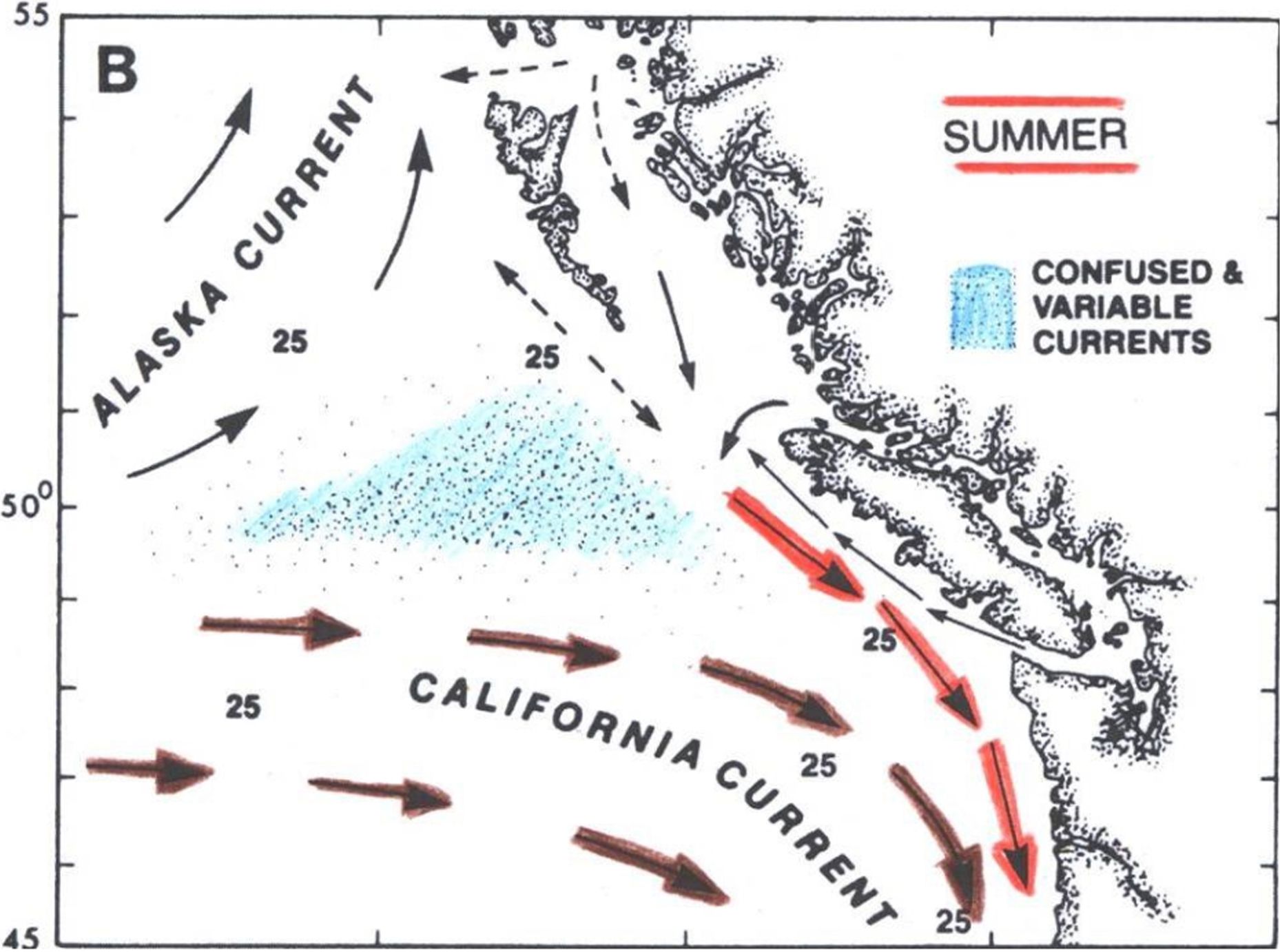
The British Columbia Coast Pilot explains the complexity of ocean movements in this larger region:
“While the drift of surface current across the ocean has an easterly component in the long run, the annual currents experienced in the region of the North Pacific current may set in any direction at anytime of the year. This is due to the fact that the currents are almost wholly produced by wind” (British Columbia Pilot 1964).
A major current than comes across the Pacific Ocean to British Columbia is the North Pacific current that branches off from the powerful Kuroshio current that sweeps along the southern coast of Japan. The Coast Pilot notes that:
“Between the parallel of 45 and 55 degrees North and the meridians of 130 degree and 140 degrees West, the east going current divides, the larger part turning south-eastward to form the California current and the smaller part turning northeastward.” (British Columbia Pilot 1964).
Detailed knowledge of the ocean currents in the more remote regions of the Pacific was not well known until more recent times. Our understanding of changes effected by climate events such as the El Nino Southern Oscillation and the Pacific Decadal Oscillation (Bremberton et. al. 2018) and more recent studies of the complexity of these current changes (Zang et. al. 2020) continue to add to our understanding of what is possible in regard to ancient Pacific voyages.
In 1997, while returning to southern California after finishing the Los Angeles to Hawaii Transpacific sailing race. Captain Charles Moore and his crew caught sight of massive amounts of trash floating in the North Pacific current Gyre, that contained mostly plastic. When this was brought to the attention of oceanographer Curtis Ebbesmeyer, who models ocean currents on the basis of flotsam movements, his studies brought about international attention. Most famous is his work with plastic rubber ducks and running shoes that fell over board from giant cargo containers off the coast of Asia (Ebbesmeyer and Ingraham Jr. 1994). He would predict, on the basis of the currents when and where the running shoes would arrive at various locations on the eastern coast of the Pacific. Ebbesmeyer had arranged with an army of the public volunteers from California to Alaska to confirm his predictions about when the shoes would likely land on shore. Time and again he was proven right.
When giving a public talk in Haida Gwaii in the early 1980s, and mentioning the running shoe study most of the people in the front row stuck their feet out to show me the running shoes that they had found on the local beaches. They were already ahead of me on this subject.
In July of 2004, while at the Paths Across the Pacific Conference in Sitka Alaska, I had the privilege of meeting Curtis Ebbesmeyer and participating in a beach search on Islands off Sitka. It became clear to me from looking into this research that larger drifting objects that could catch the wind, such as canoes, can be moved along faster than low lying objects.
Numerous highly technical studies in recent times have revealed the currents of the north Pacific are complex phenomena which require a diverse range of studies to comprehend what is or might be possible in terms of the routes travels by drifting and wind blow vessels.
Connections with British Columbia?
Debate about the origin of Polynesians was popularized in 1947, when Norwegian explorer Thor Heyerdahl tested his ideas about cultural relationships between South American and Polynesia by sailing a raft across a part of the Pacific on the famous Kon-Tiki expedition. Heyerdalh was one of the early proponents of the idea that at least some of the people of
the Polynesian Islands had their origins in the coastal region of British Columbia (Heyerdalh 1952). Given how little we know about the indigenous history of British Columbia, I encouraged Thor on his visits to the RBCM (figure 8) to pursue his interest in some of his older ideas which I believe are still open for discussion. I have subsequently proposed a number of potential cultural connections between B.C. and Polynesia (Keddie 2014).
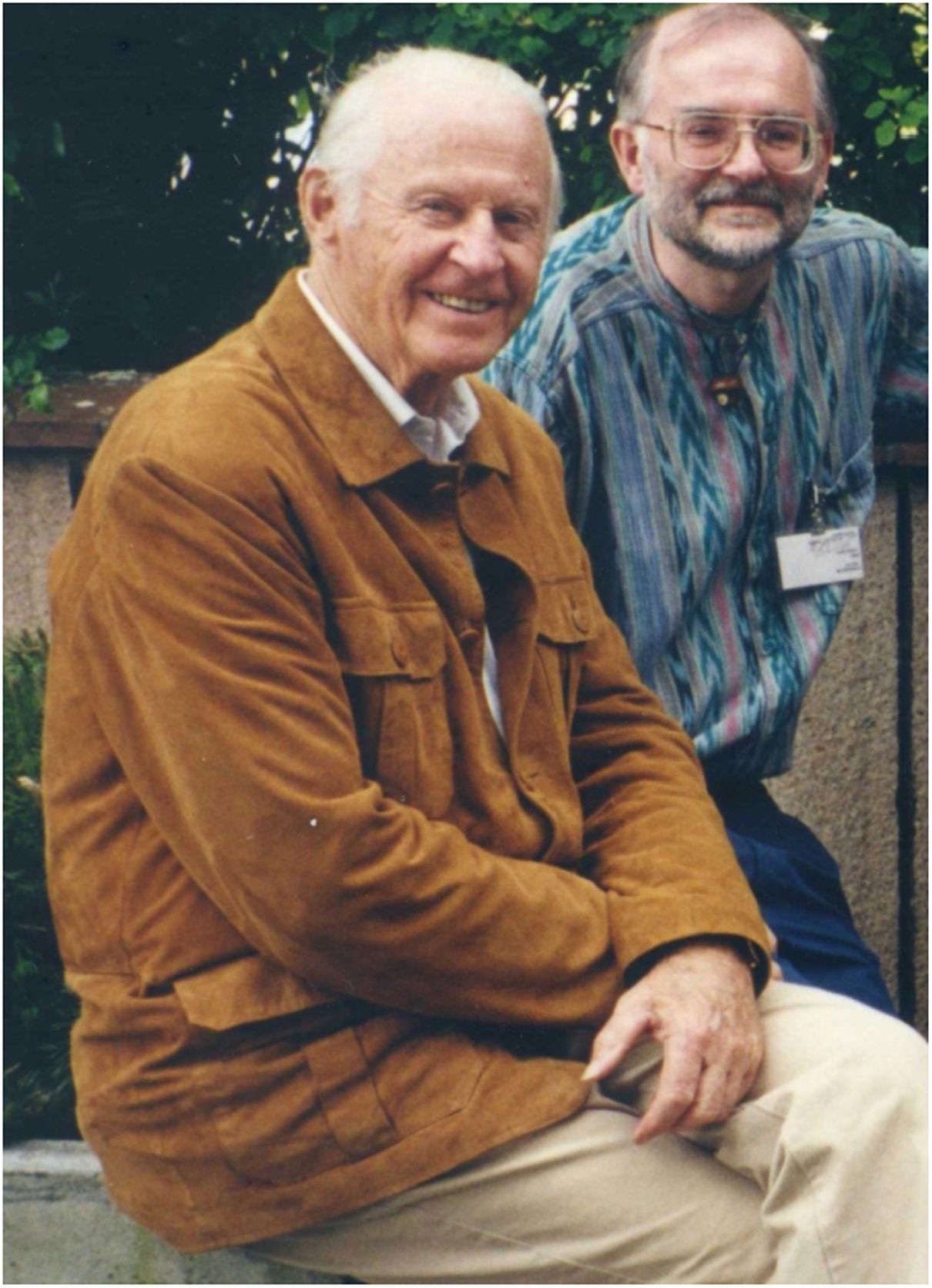
There is further work that needs to be done on this subject. Most Indigenous populations of British Columba have not had comprehensive DNA analysis to allow comparison with that of Polynesians. A recent DNA study has identified Indigenous American ancestry in people from Rapa Nui (Easter Island), and the eastern Polynesian islands of Palliser, Nuku Hiv (Northern Marquesas), Fatu Hiva (Southern Marquesas) and Mangareva. They suggest that the Zenu people of Columbia carry the DNA most like that found in Polynesians. They estimate that this genetic dispersal to eastern Polynesia happened between about 1150 A.D. and 1230 A.D. (loannidis, et. al. 2020).
Historic Influences of the Story?
Legends and myths told in the late 19th century can be influenced and modified by knowledge of the time. The Haida story of Those Who Were Blown to Sea from Nasto was told at a time when Indigenous people of coastal British Columbia were aware of the existence of Hawaii and other lands across the western ocean.
The Haida were aware of the Hawaiians (Kanakas) who worked for the Hudson’s Bay Company in the early to mid 1800s (see Barman 2020). Haida involved in the commercial sealing industry were in contact with Hawaiians at sea. Haida, Solomon Wilson (January 30,1887 – January 13, 1980), of Skidegate, wrote to ethnologist William Beyon in 1950:
“My uncle was a seal hunter. He hunted off the west coast of Vancouver Island, as the Haida canoes went far away for the seal hunt, even as far as the shores of what is now known as the Oregon coast. It is said that they would go away out to sea seeking seal herds. It was then that they would encounter the Ha’wa’I (Hawaiians) and get from them new songs, which had originated from these islanders” (Barbeau 1953:414).
Stories about people or supernatural creatures coming from across the ocean are not uncommon on the northern coast of British Columbia and Alaska. We cannot rule out that some aspects of the Nesto story were added to an old Indigenous story. However, the name Hawaii or a place name equivalent is not mentioned in this story, making it more likely to be an older pre-contact legend.
Conclusion
The details in the story of, Those Who Were Blown to Sea from Nasto, and our current knowledge of the complexity of winds and currents in this region of the coast suggests that a canoe trip from Haida Gwaii to Hawaii and back is a real possibility. Were there other trips not recorded?
Further studies in the Archaeology of British Columbia and more comprehensive DNA analysis is needed to examine the broader question of ancient cultural connections between cultures of Hawaii and those of the Northwest Coast.
References
Barbeau, Marius. 1953. Haida Myths Illustrated in Argillite Carvings. Bulletin No. 127. Anthropological series No. 32.Department of Resources and Development. National Parks Branch. National Museum of Canada.
Barman, Jean. 2020. New Land. New Lives. In: On the Cusp of Contact. Gender, Space and Race in the Colonization of British Columbia, pp 295- 322. Harbour publishing Madeira Park. British Columbia.
British Columbia Pilot. 1964. Vol. 1 Eighth Edition. Dominion of Canada, Ottawa.
Dawson, George. 1880. Geological Survey of Canada. Reports of Explorations and Surveys. 1878-9. Appendix A. On The Haida Indians of the Queen Charlotte Islands. Pp. 103-171. Appendix B. On the Vocabulary of the Haida Indians. Pp. 177-189. Dawson Brothers, Montreal.
Dixon, George. 1789. A Voyage Round the World; But More Particularly to the North-West Coast of America : Performed in 1785,1786,1787 and 1788, in the King George and Queen Charlotte, Captains Portlock and Dixon. 2 nd edition, George Goulding, London.
Ebbesmeyer, Curtis C. and Eric Scigliano. 2009. Floatametrics and the Floating World: How one Man’s Obsession with Runaway Sneakers and Rubber Ducks Revolutionized Ocean Science. HarperCollins.
Ebbesmeyer, Curtis C. and W. James Ingraham Jr. 1994. Pacific Toy Spill Fuels Ocean Current Pathways Research. Earth in Space. 7 (2): 7-9.
Everett, WilliamT. and Robert L. Pitman. 1993. Status and Conservation of Shearwaters of the North Pacific. In: Vermeer, K.; Briggs, K.T.; Morgan, K.H.; Siegel-Causey, D. (eds.). The status, ecology and conservation of marine birds of the North Pacific. Canadian Wildlife Sen. Spec. PubL, Ottawa.
Fernandez P, Anderson DJ, Sievert PR, Huyvaert KP. 2001. Foraging destinations of three low-latitude albatross (Phoebastria) species. J Zool 254: 391-404.
Stone, Sarah; Roland force and Maryanne Force. 1968. Art and Artifacts of the 18,h Century: Objects in the Leverian Museum. Bernice Pauahi Bishop Museum. Bishop Museum Press. Honolulu, Hawaii.
Heyerdalh, Thor. 1952. American Indians of the Pacific. The Theory behind the Kon-tiki expedition. London. George Alan and Unwin Ltd.
Howell, E. A., Bograd, S. J., Morishige, C„ Seki, M. R & Polovina, J. J. 2012. On North Pacific circulation and associated marine debrisconcentration. Mar. Pollut. Bull. 65,16-22.
Hyrenbach, David, P. Fernandez, D.J. Anderson. 2002. Oceanographic habitats of two sympatric North Pacific albatrosses during breeding season. Marine Ecology Progress Series. Vol. 233: 283-301
loannidis, Alexander G., Javier Blanco-Portillo, Karla Sandoval, Erika Hagelberg, Juan Francisco Miquel-Poblete, J. Victor Moreno-Mayar, Juan Esteban Rodriguez-Rodriguez, Consuelo D. Quinto-Cortes, Kathryn Auckland. Tom Parks, Kathryn Robson, Adrian V. S. Hill, Maria C. Avila-Arcos, Alexandra Sockell, Julian R. Homburger, Genevieve L. Wojcik, Kathleen C. Barnes. Luisa Herrera, Soledad Berrios, Monica Acuna, Elena Hop, Celeste Eng, Scott Huntsman, Esteban G. Burchard, Christopher R. Gignoux, Lucia Cifuentes, Ricardo A. Verdugo, Mauricio Moraga, Alexander J. Mentzer. Carlos D. Bustamante & Andres Moreno-Estrada. 2020. Native American gene flow into Polynesia predating Easter Island settlement. Nature. 583:572-577.
Kappes MA, Shaffer SA, Tremblay Y, Foley DG, Palacios DM, et al. 2010. Hawaiian albatrosses track interannual variability of marine habitats in the North Pacific. Progress in Oceanography 86:246-260.
Keddie, Grant. 2014. Cultural Connections between Polynesia and British Columbia? In: Ingerd Hoem (editor) Thor Heyerdahl’s Kon-Tiki in New Light. The Kon-Tiki Museum Occassional Papers. Volume 14:143-154. The Thor Heyerdahl Institute.
Kukulka, T, Proskurowski, G„ Moret-Ferguson, S„ Meyer, D. & Law, K. The effect of wind mixing on the vertical distribution of buoyant plastic debris. Geophys. Res. Lett. 39,1-6 (2012).
Lebreton, L„ Slat. B„ Ferrari, F. et al. 2018. Evidence that the Great Pacific Garbage Patch is rapidly accumulating plastic. Nature, Scientific Reports 8,4666 .
Qiu, B. 8i Chen, S. Variability of the Kuroshio extension jet, recirculation gyre, and mesoscale eddies on decadal time scales. J. Phys.
Oceanogr. 35, 2090-2103 (2005).
Shaffer, Scott A., Henri Weimerskirch, Darren Scott, David Pinaud, David R. Thompson, Paul M. Sagar, Henrik Moller, Graeme A. Taylor, David G.
Foley, Yann Tremblay. Daniel P. Costa. 2009. Spatiotemporal habitat use by breeding sooty shearwaters Puffinus griseus. Marine Ecology Progress Series 391:209-220.
Swanton, John R.. 1905. Contributions to the Ethnology of the Haida. The Jessup North Pacific Expedition, edited by Franz Boas. Memoir of the American Museum of Natural History. Volume V.New York 8i E.J. Brill Ltd, Leiden.
Swanton, R. John. 1908. Those Who Were Blown to Sea from Nasto. Volume 10, Part II, pp. 490-495. The Jessup North Pacific Expedition, edited by Franz Boas. Memoir of the American Museum of Natural History. Haida Texts, Masset Dialect. G. E. Stechert, New York & E.J. Brill Ltd, Leiden.
Young, Lindsay C., Cynthia Vanderlip, David C. Duffy, Vsevolod Afanasyev, Scott A. Shaffer. 2009. Bringing Home the Trash: Do Colony-Based Differences in Foraging Distribution Lead to Increased Plastic Ingestion in Laysan Albatrosses? Plus One. October 28.
Vermeer K. and I. Rankin. 1984. Pelagic Seabird Populations in Hecate Strait and Queen Charlotte Sound: Comparison with the West Coast of the Queen Charlotte Island. Canadian Wildlife Service. Institute of Ocean Sciences Department of Fisheries and Oceans Sidney, B.C. Canadian Technical Report of Hydrography and Ocean Sciences No.52.
Whittow GC. 1993. Laysan albatross (Phoebastria immutabilis}. In: Poole A, Gill F, editors. The birds of North America. Washington, D.C.: The Academy of Natural Sciences and The American Ornithologists’ Union, no 66.
